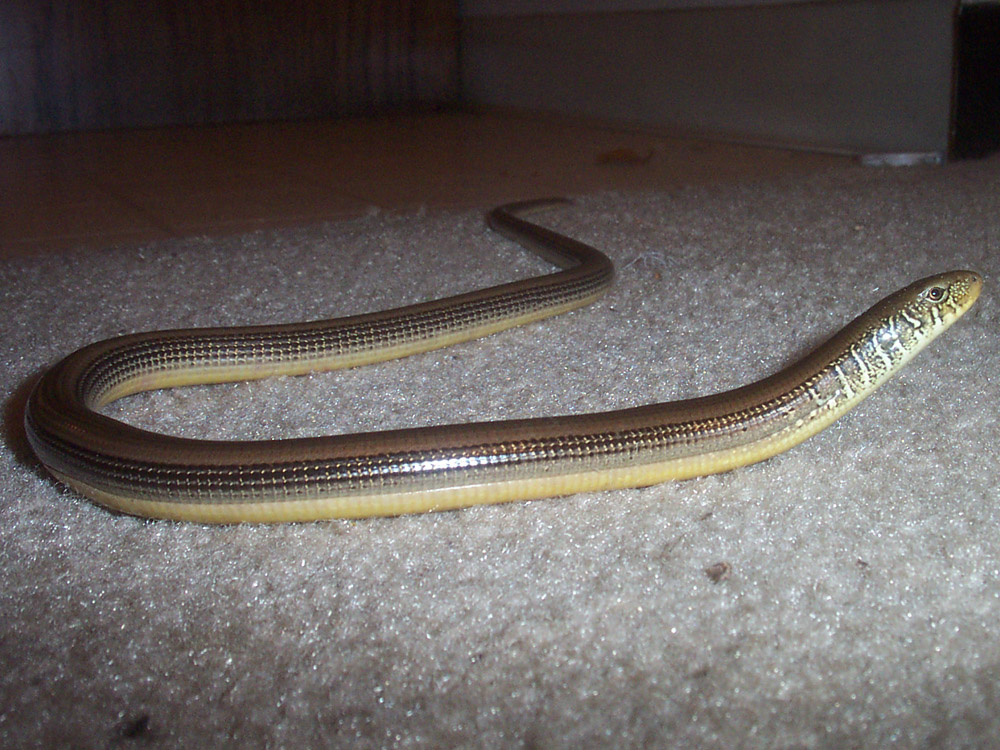|

 |
This Glass Lizard is a legless lizard, not a snake. It has eyelids! |
 |
DESCRIPTION: A lizard on my
rug.
If you need snake removal in your town, click for the National Directory of
Snake Removal Companies that I've carefully compiled in every USA city.
The glass lizard is a legless species of lizard, and is often called a glass snake. They can reach up to four feet long, but more than half of that length is their tail. They are often mistaken for snakes because of their long, slender and legless bodies, but possess all qualities of a lizard. These qualities include:
• Moveable eyelids
• Inflexible jaws
• External ear openings
• Ability to detach and regrow tails
These lizards are light brown to greenish in color and have vertical white lines on the back of their heads. Younger glass lizards are more brightly colored then their older counterparts. Glass lizards are found most often in sandy parts of the Coastal Plain. They like flatwoods and wetlands in sandy places. They are also extremely common in coastal dune habitats and like to get under tidal debris from time to time.
When threatened, they will voluntarily lose part or all of their tail to keep their predator distracted while they get away. It takes a significant amount of time, months or years depending on the size, and energy to regrow their tail because it comprises around half of their body. The regrown tail will be smaller than the original.
Glass lizards actively look for food during the day but keep a hiding place in debris nearby for safety. They eat a variety of spiders, insects, small reptiles, and sometimes small rodents. The predators of glass lizards include birds of prey, snakes, and mammals.
Breeding takes place in early summer when female glass lizards lay eggs in a protected place like a log or dense undergrowth. Unlike most lizards, she will then tend to the nest until they hatch. While most glass lizard species lay eggs, a few give birth to live young.
Glass lizards are fairly abundant and are not under protected status at this time.
Running a wildlife removal business in the state of Florida gives me the chance to see all kinds of interesting snakes! Florida has about 45 species of snake, and I've seen 29 of them so far. I've always got my eye out for new species, and
I love spotting rare snakes in Florida. I also have a thing for venomous snakes - they're not too common in FL, so I always enjoy the chance to see a poisonous serpent. I really like snakes, and I've never hurt or killed one. They're an
important part of the ecosystem, and often persecuted. Still, if you don't want snakes in your house or on your property, and judging from the number of phone calls I receive regarding snake problems, you don't, then give me or a local snake
expert in your area a call, and we can remove the snakes from your property for you. I use many snake control methods - from snake traps, to snake repellents, to habitat modification, but most of all, good old-fashioned capture and removal.
If you want to learn more, please read my How To Get Rid of Snakes page.
AAAnimal Control is a privately owned wildlife removal and pest control business, located in Orlando Florida. I deal strictly with wild animals including snakes inside houses. I am not an extermination company, but a critter removal
and control specialist. The above photos are some of the many that I've taken in the field over my years of work. Please email me if
you have any questions about the above photographs, or any questions about
wildlife problems or Florida snake removal issues.
You can safely catch snakes with a special trap, which you can order by clicking this banner:

|
| |
|